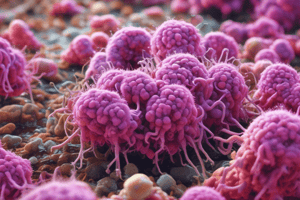Podcast
Questions and Answers
What is the disease name associated with Bacillus anthracis?
What is the disease name associated with Bacillus anthracis?
- Influenza
- Tuberculosis
- Anthrax (correct)
- Malaria
What domain classification does Bacillus anthracis fall under?
What domain classification does Bacillus anthracis fall under?
- Plantae
- Fungi
- Animalia
- Bacteria (correct)
Bacillus anthracis is a prokaryotic organism.
Bacillus anthracis is a prokaryotic organism.
True (A)
What is the morphology of Bacillus anthracis when stained?
What is the morphology of Bacillus anthracis when stained?
Bacillus anthracis produces spores.
Bacillus anthracis produces spores.
Is Bacillus anthracis motile?
Is Bacillus anthracis motile?
What type of oxygen requirements does Bacillus anthracis have?
What type of oxygen requirements does Bacillus anthracis have?
What are the distinguishing features of Bacillus anthracis?
What are the distinguishing features of Bacillus anthracis?
Who are considered high risk individuals for Bacillus anthracis exposure?
Who are considered high risk individuals for Bacillus anthracis exposure?
Where does Bacillus anthracis commonly occur geographically?
Where does Bacillus anthracis commonly occur geographically?
What are the parts of the body infected by Bacillus anthracis?
What are the parts of the body infected by Bacillus anthracis?
What are the portals of entry for Bacillus anthracis?
What are the portals of entry for Bacillus anthracis?
What is the incubation period for Bacillus anthracis?
What is the incubation period for Bacillus anthracis?
Bacillus anthracis is contagious.
Bacillus anthracis is contagious.
What are serious complications of Bacillus anthracis infection?
What are serious complications of Bacillus anthracis infection?
What diagnostic methods are used for identifying Bacillus anthracis?
What diagnostic methods are used for identifying Bacillus anthracis?
What preventive measures are effective against Bacillus anthracis?
What preventive measures are effective against Bacillus anthracis?
Flashcards
Anthrax cause
Anthrax cause
Caused by the bacterium Bacillus anthracis.
Anthrax type - cutaneous
Anthrax type - cutaneous
Anthrax infection affecting the skin.
Anthrax type - gastrointestinal
Anthrax type - gastrointestinal
Anthrax infection of the digestive system.
Anthrax type - inhalation
Anthrax type - inhalation
Signup and view all the flashcards
Anthrax type - injection
Anthrax type - injection
Signup and view all the flashcards
Anthrax bacteria shape
Anthrax bacteria shape
Signup and view all the flashcards
Anthrax spore function
Anthrax spore function
Signup and view all the flashcards
Anthrax motility
Anthrax motility
Signup and view all the flashcards
Anthrax oxygen need
Anthrax oxygen need
Signup and view all the flashcards
Anthrax reservoir
Anthrax reservoir
Signup and view all the flashcards
Anthrax transmission - inhalation
Anthrax transmission - inhalation
Signup and view all the flashcards
Anthrax transmission - ingestion
Anthrax transmission - ingestion
Signup and view all the flashcards
Anthrax transmission - open wound
Anthrax transmission - open wound
Signup and view all the flashcards
Anthrax transmission - meat consumption
Anthrax transmission - meat consumption
Signup and view all the flashcards
Anthrax is contagious?
Anthrax is contagious?
Signup and view all the flashcards
Anthrax diagnostic tool - X-rays
Anthrax diagnostic tool - X-rays
Signup and view all the flashcards
Study Notes
Disease Overview
- Anthrax is the disease caused by Bacillus anthracis.
- It is classified as a bacterial disease.
Biological Classification
- Bacillus anthracis is a prokaryotic organism.
- It is gram-positive and appears as rod-shaped under a microscope.
Sporulation and Motility
- Bacillus anthracis forms spores, known as anthrax spores, which contribute to its durability.
- The bacterium is nonmotile and does not have the ability to move independently.
Oxygen Requirements
- This bacterium is aerobic, requiring oxygen for its survival and growth.
Types of Anthrax
- There are four primary forms of anthrax infection:
- Cutaneous anthrax (skin)
- Gastrointestinal anthrax (digestive system)
- Inhalation anthrax (lungs)
- Injection anthrax (from drug use)
Pathogenic Impact
- Bacillus anthracis primarily affects domestic and wild animals across various regions globally.
Geographic Distribution
- Anthrax cases are observed worldwide, especially in:
- Central and South America
- Sub-Saharan Africa
- Central and Southwest Asia
- Southern and Eastern Europe
- Caribbean regions
At-Risk Populations
- Individuals at higher risk of anthrax exposure include:
- Veterinarians
- Livestock producers
- Travelers to endemic areas
Reservoir for Infection
- The primary reservoirs for Bacillus anthracis are domesticated and wild animals, including:
- Cattle
- Sheep
- Goats
- Antelope
- Deer
Infection Sites
- Bacillus anthracis can infect the following areas of the host body:
- Skin (cutaneous)
- Lungs (inhalation)
- Gastrointestinal system (digestive tract)
Transmission Methods
- Transmission occurs through:
- Inhalation of spores
- Ingestion of contaminated food or water
- Entry via open wounds
- Consumption of raw or undercooked meat
Portals of Entry
- The main entry points for the bacteria into the host are:
- Lungs during inhalation
- Open skin wounds
Incubation and Illness
- The incubation period is typically within one week of exposure but may extend up to two months.
- No specific definition was provided for the period of illness.
Contagiousness
- Anthrax is not contagious between humans.
Complications
- Severe illness and death can occur as serious complications from anthrax infections.
Diagnostic Techniques
- Diagnosing anthrax may involve:
- Chest X-rays or CT scans
- Blood samples
- Swabs of skin lesions
- Spinal fluid analysis
- Respiratory secretions testing
Preventive Measures
- Prevention strategies include the use of:
- Antibiotics
- Antitoxin treatments
- Vaccination against anthrax
Studying That Suits You
Use AI to generate personalized quizzes and flashcards to suit your learning preferences.




